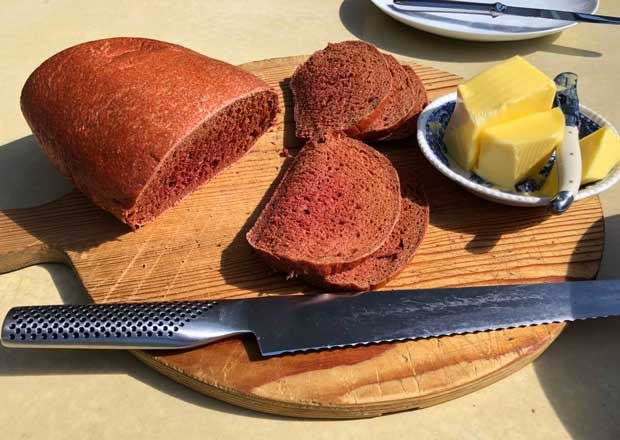Recipe: Kate’s Spelt Flour Beetroot Bread

Beetroot adds a little purple magic to this easy-to-make spelt flour loaf.
Recipe: Kate Coughlan
Look what I made when trying not to watch US politics on YouTube – bread using beetroot juice. I adapted my spelt flour recipe from an idea I saw in a video, and it works beautifully. The dough is playdough-pink, but it turns a darker shade during baking. It has no taste of beetroot whatsoever, so I am not sure what the point is, but baking bread is always fun.
INGREDIENTS
2 cups wholemeal spelt flour
2 cups high-grade white flour
1 teaspoon instant yeast granules
2 tsp sea salt
1 tbsp honey
1¾ cups liquid beetroot juice or finely ground beetroot pulp with warm water added
(To make a juicy pulp I used 2 medium beetroots, peeled, chopped into small pieces then blitzed to a pulp with ¼ cup water, then topped up to the required amount with water)
¼ cup olive oil
METHOD
In a measuring jug, mix yeast, honey and ¼ cup warm water and set aside to froth. In a large mixing bowl, add flours and salt, stir to combine.
Prepare beetroot
The original recipe uses beetroot juice, which might be most straightforward as it has no fibre and therefore doesn’t slow the cooking process. However, I used beetroot straight from the garden, cleaned, peeled and thrown into the Vitamix for processing to a liquid with added water. Add beetroot juice to the measuring jug with honey, yeast and water to make up to 1 3/4 cups adding more water if needed.

Dough
If using an electric dough hook
Pour oil in the base of the mixer bowl (to stop flour sticking to the bowl base) add flour and salt mix and set the machine on the lowest speed. Slowly pour in the beetroot juice mix until the dough is formed and rising up the dough hook. Leave the mixer on slow speed to knead for eight minutes. With oiled hands remove dough from the machine and shape into a ball and place into an oiled bowl. Cover.
By hand
In a large mixing oil, slowly add beetroot juice and stir until a dough has formed. Knead for 10 minutes until the dough is elastic and soft. It’s a work-out. Wash mixing bowl and oil lightly, place the dough in it. Cover.
Rising
In a warm and draught-free place, let the dough double in size (30-60 minutes). Remove from the bowl and gently knead again by hand for two minutes, then form into the desired shape and replace in the oiled bowl. Let it rise again for 30 minutes.
Fifteen minutes before beginning the baking, turn oven to 250C fan bake and place a dutch oven or heavy-lidded casserole into the oven to preheat.
After 15 minutes, remove dutch oven to a safe benchtop (carefully as it will be very hot), dust the sides and base with flour and place the risen dough into the dutch oven.
Baking
Crusty loaf
For a crusty bread, score the top three times on the diagonal, replace the lid and return dutch oven to the oven. Set the timer for 25 minutes.
Easy slice
For a thin, easy-to-slice crust, place the dough into the hot dutch oven, spray the surface of the dough with water and pour ¼ – ½ cup of water around the edge of the dough, replace the lid and return to the oven. (Don’t score the dough.) This causes a steam bath which seems to keep the crust thin. Set the timer for 25 minutes.
After 25 minutes, reduce the heat to 220C, remove the lid of the dutch oven and cook a further 20 minutes. If you have used beetroot juice, the bread will be ready after this. If beetroot pulp was used, let it cook a further 10 minutes. The test of bread being done is the hollow knocking sound when tapping the top of the loaf.

